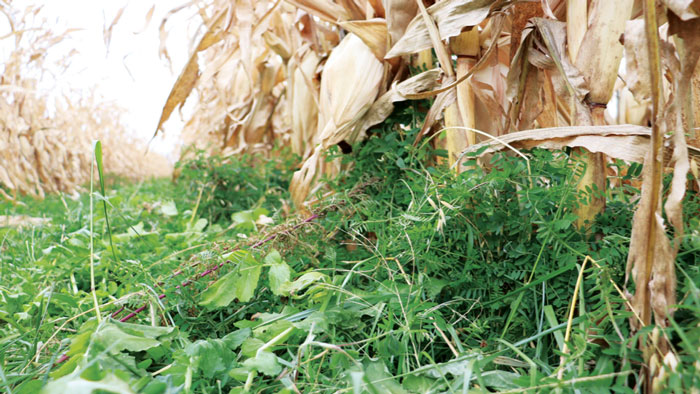Larry Tombaugh from Streator, Ill., Paul Dubbels from Fergus Falls, Minn., and Jon Stevens from Rock Creek, Minn., each shared insights about their operation at the 2023 National Strip-Tillage Conference. The trio of experienced strip-tillers fielded questions on stage from the audience. Here are some highlights from the conversation:
Can you tell us a little bit about your operation?
Dubbels: I farm with my brother about an hour southeast of Fargo. It’s always cold, and we have clay soils. I’ve been strip-tilling since 2007 with some EQIP-funded strip-till bars. We eventually took our fertilizer attachments off the planter, put them on a bar, and I guess that made us strip-tillers.
Tombaugh: I’m located about 45 miles northeast of Bloomington, Ill. I grew up on a 600-acre dairy farm. I took over in 1994 when my dad passed away. I was fortunate enough to have neighbors who were strip-tilling, so we started strip-tilling around then and implementing cover crops as well. We’re also using a lot of biologicals and humates. We used to make mistakes on our farm. Now we’ve renamed our farm to Larry Tombaugh Experimental Farms, so those mistakes are now experiments.
“What can you do to avoid a yield hit when switching to strip-till?”
Stevens: We’re located straight north from the Twin Cities, about an hour up the interstate. Nobody even acknowledges ag in my part of the state. I’ve been dabbling with no-till and strip-till since 2013. I’ve got a beef herd, and I’m mostly corn and soybeans. But I’m learning how to integrate small grains and cover crops into the rotation as well.
Do you make strips in the fall, and do you prefer using shanks or coulters?
Dubbels: We started out with a Dawn Pluribus unit. We had a single-disc opener on the planter for fertilizer. We put that on the bar and pretty much gutted our Pluribus because we were making a big strip, which was great, but we were getting some washouts on our hills. We made our own version of a strip-till bar that displaces very little dirt. It’s barely a strip, but it has eliminated erosion. With our hills, we do everything in the spring.
Stevens: We run a shank. We do spring strip-till because we’re dealing with highly erodible soil. We have the potential for blowouts with fall strip-till. I’ve tried doing some fields in the fall, but spring strip-till is nice because it gives us that fracture in the soil, it makes a nice seed bed, and we can put our nutrients down in the spring without worrying about leeching over the winter.
Have you thought about planting cover crops over the berm in the fall to help hold it through the winter and spring?
Tombaugh: We actually use cereal rye and then put the strips in. I have pictures of me planting with RTK in cereal rye that’s a foot tall in the spring. We have really good soil. There are several universities currently conducting regenerative ag studies. One of them came over and tested our soil. We have 11% carbon, 5.1% organic matter and CECs (cation exchange capacity) of 19-32.
Dubbels: We’ve flown on cereal rye as early as Aug. 1 and as late as Oct. 1. It really doesn’t seem to matter. If it comes up, it comes up. In fall of 2022, we flew it on and basically nothing came up because it was too dry. We did have a stand, though. It germinated in the spring. It’s never been a wild success, but it’s never been an abject failure either for us.
Stevens: That’s why it’s a cover crop and not a cash crop. You’ve got to have some forgiveness.

COVER CROP BENEFITS. Jon Stevens broadcasted this mix of hairy vetch, radish and buckwheat in mid-June around V3-V4. “This has significantly boosted my phosphorous levels in the soil, and the cattle love it,” he says. “I like to apply the cover crops in June because if we wait until July, it gets dry, and the seeds will just lay there until the fall.” Image: Jon Stevens
Tombaugh: We’ve tried to fly on cereal rye several times, and more often than not, it wasn’t successful. We plant earlier hybrids. As soon as we can get that off, we want to knock it down with our residue digester while there’s still juice in the stalks, and then we seed the cover crops.
Stevens: You could frost seed clover, cereal rye and species like that. Take advantage of the frozen ground and not create a muddy mess. It works really well. It’s just a management thing, deciding what you want to do in terms of termination and that kind of stuff. But using covers to stop erosion is a great idea.
How are you managing your nitrogen (N) and other fertilizers?
Dubbels: We got schooled again this year. I got too far ahead with the strip-till unit, and our strips got all dried out. Typically, we apply 50 units of N, then phosphorous (P), potassium (K), zinc and sulfur in the spring strip. In 2023, I stripped it and realized at the end that one of the tubes had fallen off behind the hitch. We had no moisture in the strip, so we no-tilled the corn in between the strips, which actually worked really well. But then as time progressed, that one tube that came off, it basically put all the fertilizer on top of the ground between the strips. When we came back and planted, we were actually now on top of that strip of fertilizer. In the wetter soil conditions, that surface-applied fertilizer was the greenest row by far. It outgrew everything.
Tombaugh: I don’t like dry fertilizer, and I really hate anhydrous. My neighbor had this new machine. He got through 60 acres for me, making strips with 40 pounds of humates. The engineers were out seven times trying to fix it, and he couldn’t get through the rest of my soybean ground. It was getting late and anhydrous was cheap — only $1,400 a ton. I called up the co-op and had them apply 100 pounds per acre, so I had strips to plant into across the rest of my soybean ground.
“I do enough foliars that my wife thinks I’m having some affair with a girl named Hagie…”
Then in the spring, we applied quite a bit with our planter — plant growth regulators (PGRs) through the center of the FurrowJet; 3-18-18 with biological products Envita, SoyFX, IONfx. I work with a fellow who makes a product called Wholeshot, and it’s got about 14 different products, including concentrated seaweeds.
I’m convinced that Y-drops don’t work unless you’re Hula or Dowdy and have irrigation. 1 year out of 3 they might work. We sidedress with end placers. You can go up to 10 mph, and we’re applying 45 gallons per acre. We shoot towards the row, and it has cover boards, so it’s covered. We do a lot of foliar stuff. I make my own compost tea. We’re mixing that with a lot of other dry soluble fertilizers and boron. I do enough foliars that my wife thinks I’m having some affair with a girl named Hagie.
What can you do to avoid a yield hit when switching to strip-till?
Stevens: It comes back to checking the basics. Make sure you don’t have air pockets, you’re not trenching too deep, and your berming discs aren’t creating water paths next to the berm. I can’t fathom in an honest scenario, if you did the basics, how you can lose money going from conventional tillage to strip-till.
Tombaugh: We didn’t really have any yield drag when we went to strip-till, and I was trying to compete against the legacy. My grandfather had 150-bushel corn in 1945. My dad had 207-bushel corn in 1958. I wasn’t able to break 250 until I got Roundup Ready corn. But when we started strip-tilling, we were getting up to around 285 before long.







